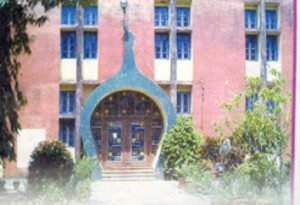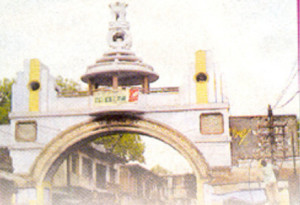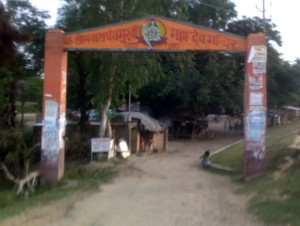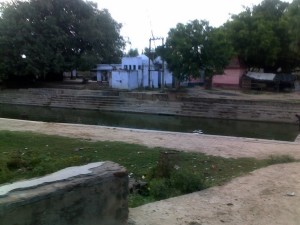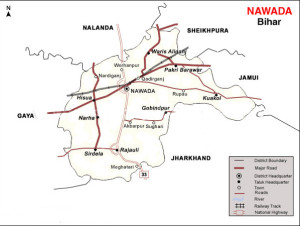 Nawada became an independent district of Bihar on January 26, 1973.It is spread over the geographical area of 2,494 sq. kms.
Nawada became an independent district of Bihar on January 26, 1973.It is spread over the geographical area of 2,494 sq. kms.
Before its acquisition by the East India Company, Nawada was ruled by the nearly independent Rajas of Hisua, and after its acquisition it was the center of great disorder till 1845, when it became the headquarters of the newly created subdivision. The elements of disorder came to fore again during the Mutiny of 1857, when Nawada was overrun by marauding parties. The local offices were destroyed, but Government records were saved by the native officials who hid them in a cave in a neighboring hill. These are the only available public records dating back to an era before 1857, in the district.
The origin of the name Nawada is believed to lie in a corruption of the old name Nau-abad or the new town which was earlier known as ‘The Eliot Market (Bazaar)’.
How To Reach
By Air (Airport):-
Nawada does not have an airport. Nearest airport is Gaya Airport about 58 km away & Patna Airport (PAT) is 84 km away
By Rail :-
Nawada Railway lies Under ECR.It connects two major railway stations Gaya jn and Kiul jn by Gaya -Kiul Line . It is also connected to cities like Gaya, Munger (Jamalpur), Bhagalpur, Kolkata (Howrah junction) etc
By Road :-
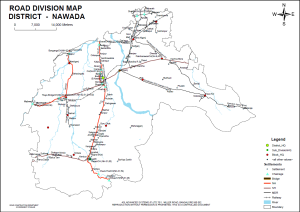 Well connected to other city through National Highway -31,82 State Highway – 8,70,71 and Other road – Quadirganj Roh Kawakol Road,Kawakol Jamui Road, Hisua Khanwa Rd,Pakribarawa Warisaliganj Rd,NH-31-Nawada Bazar Portion Nawada is well connected to the major cities like Patna, Ranchi, Jamshedpur, Bokaro, Dhanbad, Kolkata by road.
Well connected to other city through National Highway -31,82 State Highway – 8,70,71 and Other road – Quadirganj Roh Kawakol Road,Kawakol Jamui Road, Hisua Khanwa Rd,Pakribarawa Warisaliganj Rd,NH-31-Nawada Bazar Portion Nawada is well connected to the major cities like Patna, Ranchi, Jamshedpur, Bokaro, Dhanbad, Kolkata by road.
It is 105 km from Patna and 60 km from Gaya.
Popular tourist destinations
NAWADA BLOCK
Naradah Museum:-
Naradah Museum was established in the year 1974, with the initiative of the then District Magistrate of newly created district of Nawada Shri N. P. Singh, I.A.S. Almost all the exhibits were collected and made over to the Deptt. of Art, Culture & Youth, Govt. of Bihar by Shri Singh himself. It is a multi-purpose museum and the mention-worthy artifacts and art-objects include Pal stone sculptures, coins and manuscripts. Besides, contemporary painting, metal and stone art-pieces have also been preserved in the museum. The entire collection is housed in a magnificent building of its own.
Sankat mochan mandir And Hazrat Syed Shah Jalaluddin Bukhari :-
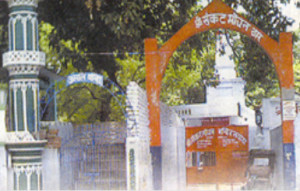 It is situated on Patna Ranchi road near south of block. Headquater.
It is situated on Patna Ranchi road near south of block. Headquater.
Republic Door:-
Adwa (Near Nawada Town):- An ancient image of Buddha was found here, which is well preserved in the Naradah Museum.
Dhuriwan (Near Nawada):- An ancient images of Padmapani & Hariti were found here, which are well preserved in the Naradah Museum.
Jipur Garh (Near Nawada):- An ancient images of Gajalakshmi & Maitreya were found here, which are well preserved in the Naradah Museum.
Mizzapur Mohalla (Nawada Town):- An ancient image of Uma-Mahesvara was found here, which is well preserved in the Naradah Museum.
Najardih (Nawada Town):- An ancient image of Vishnu was found here, which is well preserved in the Naradah Museum.
Raghopur (Nawada Town):- An ancient image of Parvati was found here, which is well preserved in the Naradah Museum.
Singorhia (Nawada Town):- An ancient images of Mahishasurmardini & Avalokitesvara were found here, which are well preserved in the Naradah Museum.
Samay:- An ancient image of Vishnu was found here, which is well preserved in the Naradah Museum.
Parwasarai (Kadirganj):- An ancient image of Balarama was found here, which is well preserved in the Naradah Museum.
Sonubigha (Kadirganj):- An ancient image of Basuki was found here, which is well preserved in the Naradah Museum.
Ataua:- An ancient image of Surya was found here, which is well preserved in the Naradah Museum.
According to Jayaswal Research Institute Archaeological Explorations this site belongs to Early medieval period.
Kena Sarai:-The KP Jayaswal Research Institute, during in the course of its Archaeological Explorations brought to light the site period Early medieval. Asarhi:-The KP Jayaswal Research Institute, during in the course of its Archaeological Explorations brought to light the site period Early medieval. Khrat:-The KP Jayaswal Research Institute, during in the course of its Archaeological Explorations brought to light the site period NBPW phase.
Neya:-An ancient image of Vishnu was found here, which is well preserved in the Naradah Museum.
According to Jayaswal Research Institute Archaeological Explorations this site belongs to NBPW phase period.
Siswan:- An ancient image of Vishnu was found here, which is kept in Naradah Museum.
According to Jayaswal Research Institute Archaeological Explorations this site belongs to Early medieval period.
Sojana:– The KP Jayaswal Research Institute, during in the course of its Archaeological Explorations brought to light the site period Early medieval. Kena:- The KP Jayaswal Research Institute, during in the course of its Archaeological Explorations brought to light the site period NBPW phase. Veli Sharif (Sonar Patti):- The KP Jayaswal Research Institute, during in the course of its Archaeological Explorations brought to light the site period Late medieval. Gonawan Garh:- The KP Jayaswal Research Institute, during in the course of its Archaeological Explorations brought to light the site period Early medieval.
Gonavan Jee :-
Gonava village is situated about one kilometer north of Nawada on Patna-Ranchi road. It is a place of pilgrimage for the Jains of both sects.
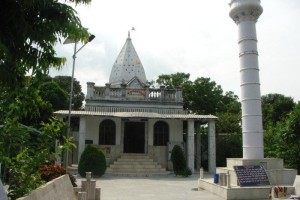 The Digambar Jain temple is just by the side of main road while the Shwetambar Jain temple is at the back of it. The Digambar Jain temple built in 1925 is quite beautiful, has a large marble idol of Lord Mahavira. The Shwetambar Jain temple was built some 800 years ago and has an impressive approach road. The temple has got a marble idol of Lord Mahavira flanked by a granite idol of Sudharmaji and idol of Panch Parmesthi made of Ashtadhatu and also a marble Lord idol of Gautama. The temple is famous and known as place of Nirvana of Lord Mahaviras 1st disciple, Gautam Gandharva.
The Digambar Jain temple is just by the side of main road while the Shwetambar Jain temple is at the back of it. The Digambar Jain temple built in 1925 is quite beautiful, has a large marble idol of Lord Mahavira. The Shwetambar Jain temple was built some 800 years ago and has an impressive approach road. The temple has got a marble idol of Lord Mahavira flanked by a granite idol of Sudharmaji and idol of Panch Parmesthi made of Ashtadhatu and also a marble Lord idol of Gautama. The temple is famous and known as place of Nirvana of Lord Mahaviras 1st disciple, Gautam Gandharva.
Here there are 40 Digamber Jain Temple along the area.
Radha Krihsna Mandir( Gonawa):-
Gonaya ji Mahraj Mandir (Gonawa):-
Charan Chinah(Gonawa ):-
Gupha Gonaya ji Mahraj Mandir(Gonawa ):-
Bengali Shakti Pith( Gonawa):-
Four Door in Gonaya ji Mahraj Mandir(Gonawa):-
Samadhi Asthal of Gonaya ji Mahraj (Gonawa):-
Jalal Bukhari Baba with Sankat Mochan Mandir:-
JalMandir ( Gonawa):-
Sri Gunavaji Digambar Jain Dharmashala:_
Shiv Temple :- It is about a km away from nawada towards Hilsa by side of Sobh Nala, it is situated, has got great religious significance.
Mugalakhar:- The KP Jayaswal Research Institute, during in the course of its Archaeological Explorations brought to light the site period Mughal Period. Rani Hatti:- The KP Jayaswal Research Institute, during in the course of its Archaeological Explorations brought to light the site period Late medieval. Anti garh:- The KP Jayaswal Research Institute, during in the course of its Archaeological Explorations brought to light the site period Early medieval. Amaunipur:– The KP Jayaswal Research Institute, during in the course of its Archaeological Explorations brought to light the site period Early medieval. Orhanpur:-The KP Jayaswal Research Institute, during in the course of its Archaeological Explorations brought to light the site period Medieval.
Shobhnath Panchmukhi Mahadev Mandir :-
Popularly known as Shobhia Mandir. Temple of God Shiva along with many other Devi Devta.A good place to conduct marriage.
Bahdauni :- An ancient site consists a 7 ft high mound yielding the N.B.P.ware.(ASI 1963-64)
Panshala (Lat. 24o59‘51‘‘N;Long.85o30‘21‘‘E):- This site is located on the eastern bank of the Panchane River.It extends in an area approximately 450 m north-south and 400 m east-west and comprises about6-7 m thick habitation deposit. Most of the site has been converted into agricultural field. Surface collection from this site contains red, black slipped and coarse grey wares. Noteworthy shapes are sprinklers, spouted pots, bowls, lids, vases etc. Areca-nut shape terracotta bead, fragment of terracotta votive tank, stone plaques depicting Ganesha and Vishnu, black stone sculptural fragments are the other notable remains found during exploration. This site may be identified as the ancient “Panchashala village i.e. Panchashalagrama” referred in Buddhist texts Samyutta Nikaya and Milinda Panha. According to Samyutta Nikaya , it was a Brahmin village of Magadh,visited by Buddha.
KASHI CHAK BLOCK
Daryapur Parbatti:- The KP Jayaswal Research Institute, during in the course of its Archaeological Explorations brought to light the site period Early medieval. Maharath:- The KP Jayaswal Research Institute, during in the course of its Archaeological Explorations brought to light the site period NBPW phase. Chandinama:- The KP Jayaswal Research Institute, during in the course of its Archaeological Explorations brought to light the site period Early medieval. Dhanpur:- The KP Jayaswal Research Institute, during in the course of its Archaeological Explorations brought to light the site period Early medieval. Bauri:-The KP Jayaswal Research Institute, during in the course of its Archaeological Explorations brought to light the site period Early medieval. Rewara:– The KP Jayaswal Research Institute, during in the course of its Archaeological Explorations brought to light the site period Early medieval.
PAKRIBARAWAN BLOCK
Pakribarawan:- An ancient image of Balrama was found here, which is well preserved in the Naradah Museum.
Dumrawan:- The KP Jayaswal Research Institute, during in the course of its Archaeological Explorations brought to light the site period Early medieval. Dheodha Garh:- The KP Jayaswal Research Institute, during in the course of its Archaeological Explorations brought to light the site period Early medieval.
MESKAUR BLOCK
Sitamarhi:- It is situated 32 km from Nawada. There is an elliptical cave carved inside a huge hemispherical block of granite rock. The legend has it that it was in this cave that sita had to take refuge after having been exiled by Rama, built by Vishwakarma. As the legend goes it was the haven for Sita and provided her protection in the dense forest which was infested with wild beasts.
According to Jayaswal Research Institute Archaeological Explorations this site belongs to NBPW phase eriod.
Barat:– It is situated 2 km from Sitamarhi, where the saint poet Valmiki is said to have lived when sita was exiled. It was on the wide high level ground near this cave that sita’s sons Lava and Kusha are said to have fought against Rama’s army.
According to Jayaswal Research Institute Archaeological Explorations this site belongs to Medieval period.
Arandi:- The KP Jayaswal Research Institute, during in the course of its Archaeological Explorations brought to light the site period Early medieval. Mirzapur:– The KP Jayaswal Research Institute, during in the course of its Archaeological Explorations brought to light the site period Early medieval. Adgawan:- The KP Jayaswal Research Institute, during in the course of its Archaeological Explorations brought to light the site period NBPW phase. Harla:– The KP Jayaswal Research Institute, during in the course of its Archaeological Explorations brought to light the site period Early medieval. Repurasirsa:- The KP Jayaswal Research Institute, during in the course of its Archaeological Explorations brought to light the site period Early medieval. Baijnathpur:- The KP Jayaswal Research Institute, during in the course of its Archaeological Explorations brought to light the site period Early medieval. Naksena:– The KP Jayaswal Research Institute, during in the course of its Archaeological Explorations brought to light the site period Early medieval. Sarai:- The KP Jayaswal Research Institute, during in the course of its Archaeological Explorations brought to light the site period Early medieval. Barosar:- The KP Jayaswal Research Institute, during in the course of its Archaeological Explorations brought to light the site period Late medieval. Bandhi:- The KP Jayaswal Research Institute, during in the course of its Archaeological Explorations brought to light the site period Early medieval. Bisiait:- The KP Jayaswal Research Institute, during in the course of its Archaeological Explorations brought to light the site period Early medieval. Majhla:- The KP Jayaswal Research Institute, during in the course of its Archaeological Explorations brought to light the site period Early medieval. Hero:- The KP Jayaswal Research Institute, during in the course of its Archaeological Explorations brought to light the site period Early medieval. Dewara:- The KP Jayaswal Research Institute, during in the course of its Archaeological Explorations brought to light the site period Early medieval. Rasulpur:- The KP Jayaswal Research Institute, during in the course of its Archaeological Explorations brought to light the site period Early medieval. Jarahiya:- The KP Jayaswal Research Institute, during in the course of its Archaeological Explorations brought to light the site period Early medieval. Lokhaura:- The KP Jayaswal Research Institute, during in the course of its Archaeological Explorations brought to light the site period Early medieval. Lakshmipur:-The KP Jayaswal Research Institute, during in the course of its Archaeological Explorations brought to light the site period Early medieval. Kopin:- The KP Jayaswal Research Institute, during in the course of its Archaeological Explorations brought to light the site period NBPW phase. Katghara:- The KP Jayaswal Research Institute, during in the course of its Archaeological Explorations brought to light the site period Early medieval. Dhangawan:- The KP Jayaswal Research Institute, during in the course of its Archaeological Explorations brought to light the site period Early medieval. Merhkuri:- The KP Jayaswal Research Institute, during in the course of its Archaeological Explorations brought to light the site period Early medieval. Kanungo Bigha:- The KP Jayaswal Research Institute, during in the course of its Archaeological Explorations brought to light the site period Early medieval. Shivganj:- The KP Jayaswal Research Institute, during in the course of its Archaeological Explorations brought to light the site period Early medieval. Biju Bigha:- The KP Jayaswal Research Institute, during in the course of its Archaeological Explorations brought to light the site period Medieval. Noni:- The KP Jayaswal Research Institute, during in the course of its Archaeological Explorations brought to light the site period Early medieval. Pathra:- The KP Jayaswal Research Institute, during in the course of its Archaeological Explorations brought to light the site period Early medieval. Paroria:- The KP Jayaswal Research Institute, during in the course of its Archaeological Explorations brought to light the site period Early medieval.
NARHAT BLOCK
Dargah Hazrat Khwaja Abdullah Chisty Rahmatullahi Allaih, Chhota Sheikhpura:- Dargah of Hazrat Syed Khaja Abdullah Chishti Bhakkari, Faridi Nizami and his son Qutubuddin Thani and Grandson Taj Mahmud Haqqani Chishti at Village Chhota Sheikhpura
They belong to Khwaja Maudood Chishti family of Hira Afghanistan the well known great Sufi Master and teacher of Hazrat Haji Sharif Zindani, Rahmatullahi Allaih Chishti order before Hazrat Khwaja Moinuddin Chishti.
Ganjapur:- The KP Jayaswal Research Institute, during in the course of its Archaeological Explorations brought to light the site period Early medieval. Rampur:- The KP Jayaswal Research Institute, during in the course of its Archaeological Explorations brought to light the site period Early medieval. Punaul:- The KP Jayaswal Research Institute, during in the course of its Archaeological Explorations brought to light the site period Early medieval. Shekhpura:- The KP Jayaswal Research Institute, during in the course of its Archaeological Explorations brought to light the site period Early medieval.
Milkitola Masjid of Chhota Sheikhpura:-
Barauta:-The KP Jayaswal Research Institute, during in the course of its Archaeological Explorations brought to light the site period Early medieval. Kachpura:- The KP Jayaswal Research Institute, during in the course of its Archaeological Explorations brought to light the site period Early medieval. Sinduari:- The KP Jayaswal Research Institute, during in the course of its Archaeological Explorations brought to light the site period Early medieval. Chhoti Pali:- The KP Jayaswal Research Institute, during in the course of its Archaeological Explorations brought to light the site period Early medieval. Bhim Bigha:– The KP Jayaswal Research Institute, during in the course of its Archaeological Explorations brought to light the site period Early medieval. Bari Pali:- The KP Jayaswal Research Institute, during in the course of its Archaeological Explorations brought to light the site period Early medieval. Chatar:– The KP Jayaswal Research Institute, during in the course of its Archaeological Explorations brought to light the site period Early medieval. Badhnaur:- The KP Jayaswal Research Institute, during in the course of its Archaeological Explorations brought to light the site period Early medieval. Kusha:- The KP Jayaswal Research Institute, during in the course of its Archaeological Explorations brought to light the site period Early medieval. Shagazipur:- The KP Jayaswal Research Institute, during in the course of its Archaeological Explorations brought to light the site period Early medieval. Jamuara:- The KP Jayaswal Research Institute, during in the course of its Archaeological Explorations brought to light the site period Early medieval. Gajrachatar:- The KP Jayaswal Research Institute, during in the course of its Archaeological Explorations brought to light the site period Early medieval. Abgil:- The KP Jayaswal Research Institute, during in the course of its Archaeological Explorations brought to light the site period Early medieval. Raja Bigha:- The KP Jayaswal Research Institute, during in the course of its Archaeological Explorations brought to light the site period Early medieval. Narhat:- The KP Jayaswal Research Institute, during in the course of its Archaeological Explorations brought to light the site period Early medieval. Walipur:- The KP Jayaswal Research Institute, during in the course of its Archaeological Explorations brought to light the site period Early medieval. Ankari:- The KP Jayaswal Research Institute, during in the course of its Archaeological Explorations brought to light the site period Early medieval. Konibar:- The KP Jayaswal Research Institute, during in the course of its Archaeological Explorations brought to light the site period Early medieval. Bazidpur:- The KP Jayaswal Research Institute, during in the course of its Archaeological Explorations brought to light the site period Early medieval. Ebrahimpur:- The KP Jayaswal Research Institute, during in the course of its Archaeological Explorations brought to light the site period Early medieval. Banan Bigha:- The KP Jayaswal Research Institute, during in the course of its Archaeological Explorations brought to light the site period Early medieval. Patal Bigha:- The KP Jayaswal Research Institute, during in the course of its Archaeological Explorations brought to light the site period Early medieval. Punthar:- The KP Jayaswal Research Institute, during in the course of its Archaeological Explorations brought to light the site period Early medieval. Khanwan:- The KP Jayaswal Research Institute, during in the course of its Archaeological Explorations brought to light the site period Early medieval. Milki:- The KP Jayaswal Research Institute, during in the course of its Archaeological Explorations brought to light the site period Early medieval. Derhgaon:- The KP Jayaswal Research Institute, during in the course of its Archaeological Explorations brought to light the site period Early medieval. Daulatpur:- The KP Jayaswal Research Institute, during in the course of its Archaeological Explorations brought to light the site period Early medieval. Gangta:- The KP Jayaswal Research Institute, during in the course of its Archaeological Explorations brought to light the site period Early medieval. Hamidpur Bara:- The KP Jayaswal Research Institute, during in the course of its Archaeological Explorations brought to light the site period Early medieval. Tarapur:- The KP Jayaswal Research Institute, during in the course of its Archaeological Explorations brought to light the site period Early medieval. Gowasa:- The KP Jayaswal Research Institute, during in the course of its Archaeological Explorations brought to light the site period Early medieval. Saidapur:- The KP Jayaswal Research Institute, during in the course of its Archaeological Explorations brought to light the site period Early medieval. Punaul Beldaria:- The KP Jayaswal Research Institute, during in the course of its Archaeological Explorations brought to light the site period Early medieval. Karman:- The KP Jayaswal Research Institute, during in the course of its Archaeological Explorations brought to light the site period Early medieval.
GOVINDPUR BLOCK
Koyalia:- The KP Jayaswal Research Institute, during in the course of its Archaeological Explorations brought to light the site period Late medieval. Sughari:- The KP Jayaswal Research Institute, during in the course of its Archaeological Explorations brought to light the site period Early medieval. Mahugain:- The KP Jayaswal Research Institute, during in the course of its Archaeological Explorations brought to light the site period Early medieval. Pathra:- The KP Jayaswal Research Institute, during in the course of its Archaeological Explorations brought to light the site period Early medieval.
Kakolat :- Kakolat is the name of a waterfall located near Govindpur police station in Gobindpur block, about 32 km away from Nawada. Water fall of cool chilled water, best season for visit this place is summer, a swimming pool is making by Bihar government for swimming & take bath, The fall is about 150 to 160 feet, from the ground level.Just below the fall there is a deep reservoir natural in character. The scene is panoramic due to all-round green forest area, which is very pleasant to the eyes. The fall derives its name from Kol, a tribal people who inhabited this area once upon a time.A legend is prevalent that in Treta Yuga a king named was cursed by a rishi and had to take the shape of a python and lived here. The place was visited by the great Pandavas during their exile and the accursed king got salvation from the damnation. The king after getting rid of the curse proclaimed that one who would bathe in the waterfall will not take the yoni of snake and that is why a large number of people from far and near bathe in the river. A big fair is held on the occasion of bishua or Chaitra Sankranti.
Another story about Kakolat Kund(above the hill)is that the Lord Krishna Used to go there with his queen.
According to Jayaswal Research Institute Archaeological Explorations this site belongs to Late Medieval period.
Kol Mahadev:- It is about 2 km from Kokolat.The reservoir of the Kol dam built on the Kolmahadev(bhusari) River present a picturesque sight. Side of the dam Shiva Temple named Kol Mahadev is situated. It enshrines a Granite Shivling which is about 18″ in height with an imprint of Trishul.Besides there is an idol of Gauri along with Ganesh,Mahavira and Bharava all engraved in one single granite stone block. According the local legend these idols are very ancient. Bahyara:- The KP Jayaswal Research Institute, during in the course of its Archaeological Explorations brought to light the site period Late medieval. Rampur:- The KP Jayaswal Research Institute, during in the course of its Archaeological Explorations brought to light the site period Early medieval. Bhawanpur:- The KP Jayaswal Research Institute, during in the course of its Archaeological Explorations brought to light the site period Early medieval. Pahraitha:- The KP Jayaswal Research Institute, during in the course of its Archaeological Explorations brought to light the site period Early medieval. Purna Dih:- The KP Jayaswal Research Institute, during in the course of its Archaeological Explorations brought to light the site period Early medieval. Ektara:– The KP Jayaswal Research Institute, during in the course of its Archaeological Explorations brought to light the site period Early medieval. Sarkanda:- The KP Jayaswal Research Institute, during in the course of its Archaeological Explorations brought to light the site period Gupta. Darshan:– The KP Jayaswal Research Institute, during in the course of its Archaeological Explorations brought to light the site period Early medieval. Madhopur:- The KP Jayaswal Research Institute, during in the course of its Archaeological Explorations brought to light the site period Late medieval. Bishnupur:- The KP Jayaswal Research Institute, during in the course of its Archaeological Explorations brought to light the site period Early medieval. Darmaniya Bazar:– The KP Jayaswal Research Institute, during in the course of its Archaeological Explorations brought to light the site period Early medieval. Govindpur:- The KP Jayaswal Research Institute, during in the course of its Archaeological Explorations brought to light the site period Early medieval.
Sun Temple (Govindpur):- The Temple has been to 12 century A.D. The temple is said to have been erected by a Mega priest and counselor of Manaprince Rudramana.
Chati Gobindpur :- This village is Located near Govindpur contains two ancient pillars which are locally associated with emperor Ashoka and the Afghan chief Sher Shah.
Charak Pather :- It is situated near Govindpur, has a very large ancient boulder of white stone. It drives its name from this stone.
Siur :- It is about 8 km north – west of Govindpur, noted for some very large mounds of ruins. The mounds deseve excavation and archaeological study.
Baksanti:- An ancient image of dancing figures was found here, which is well preserved in the Naradah Museum.
ROH BLOCK
Marvi:- An ancient images of Bodhisattva & architectural fragment with Surya were found here, which are well preserved in the Naradah Museum.
According to Jayaswal Research Institute Archaeological Explorations this site belongs to Early medieval period.
Bhatta:- The KP Jayaswal Research Institute, during in the course of its Archaeological Explorations brought to light the site period NBPW phase. Rupon:- The KP Jayaswal Research Institute, during in the course of its Archaeological Explorations brought to light the site period Early medieval. Siur:- The KP Jayaswal Research Institute, during in the course of its Archaeological Explorations brought to light the site period Early medieval. Ohari:-The KP Jayaswal Research Institute, during in the course of its Archaeological Explorations brought to light the site period NBPW phase. Samhrigarh:- The KP Jayaswal Research Institute, during in the course of its Archaeological Explorations brought to light the site period Early medieval.
Mahrawan:- An ancient image of inscribed architectural fragment with Vishnu were found here, which are well preserved in the Naradah Museum.
According to Jayaswal Research Institute Archaeological Explorations this site belongs to NBPW phase period..
Roh:- In the course of exploration done by Archaeological Survey of India in 75-76 located an ancient site revealing ancient structural and several sculptural vestiges datable to the eighth-ninth century AD.Noteworthy among them are remains of the structures, probably of a temple or stupa, a well with dia of 3.75 m, sculptures of Vishnu, a stone relief of seventy-six Buddhas in Bhumisparsa mudra in four row with equal numbers of figures in each row,Buddha, Ganesh and Uma-Mahesvara and a brick enclosure with many image of the Brahmanical faith such as Ganesha, Vishnu, Siva-Parvati and a Linga.
According to Jayaswal Research Institute Archaeological Explorations this site belongs to Pre NBPW phase period.
Mandra (Marra):- An ancient images of Nrisimha, Ganesha & Uma-Mahesvara were found here, which are well preserved in the Naradah Museum.
According to Jayaswal Research Institute Archaeological Explorations this site belongs to Early medieval period.
NARDIGANJ BLOCK
Ghosrawon village :- It is situated 3 Km east of Pawapuri. The village is famous for its art of carving relief on stone. Some ancient stone images have also been found in the village.
Tetrawan village Temple :- It is situated about 3 km north of Ghosarawan village.
Handiya:- The KP Jayaswal Research Institute, during in the course of its Archaeological Explorations brought to light the site period Early medieval.
Handiya Sun Temple :–The Handiya Surya Mandir is very ancient and is believed to be of Dwapara Yuga. It is situated approximately 6 kms south-west of Rajgir. People worship Surya Narayana here and the temple complex has many ancient statues, which have been damaged with the passage of time. The statue of Surya Narayana is of black stone, the chariot has seven horses attached to it.
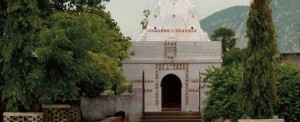 Constructed at the time of King Jarasandha, it is said his daughter Dhaniya was suffering from leprosy and used to visit this temple daily for worship. As the legend goes, she used to bath in the nearby pond and was cured. Later Dhaniya established a temple of Ma Bhagwati in a nearby village and a Shivalinga at Dhaniya hill, which is 2 kms away from the main temple. Here Ma Bhagwati is established in two forms and statues are of black stone.
Constructed at the time of King Jarasandha, it is said his daughter Dhaniya was suffering from leprosy and used to visit this temple daily for worship. As the legend goes, she used to bath in the nearby pond and was cured. Later Dhaniya established a temple of Ma Bhagwati in a nearby village and a Shivalinga at Dhaniya hill, which is 2 kms away from the main temple. Here Ma Bhagwati is established in two forms and statues are of black stone.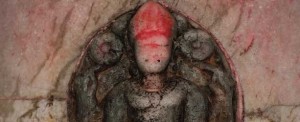
The uniqueness of this Shivalinga is that it contains depiction of Gauri and Shankara simultaneously.
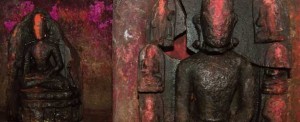 Every Sunday thousands of people suffering from leprosy come to the temple to worship Surya Narayana. First they take bath in the nearby historic pond and then come to the temple to offer prayers. Again they go back to the pond, take bath and come to the temple with water to offer to the deity. The priest then gives them special ashes called bhabhoota to rub on the skin for treatment. It is in the month of Chaitra and Kartik, that a fair is held here in which thousands of devotees come from far and wide.
Every Sunday thousands of people suffering from leprosy come to the temple to worship Surya Narayana. First they take bath in the nearby historic pond and then come to the temple to offer prayers. Again they go back to the pond, take bath and come to the temple with water to offer to the deity. The priest then gives them special ashes called bhabhoota to rub on the skin for treatment. It is in the month of Chaitra and Kartik, that a fair is held here in which thousands of devotees come from far and wide.
Chiraiya:- The KP Jayaswal Research Institute, during in the course of its Archaeological Explorations brought to light the site period Medieval. Masaurha:- The KP Jayaswal Research Institute, during in the course of its Archaeological Explorations brought to light the site period Medieval. Nenaura:- The KP Jayaswal Research Institute, during in the course of its Archaeological Explorations brought to light the site period Early medieval. Kahuara:-The KP Jayaswal Research Institute, during in the course of its Archaeological Explorations brought to light the site period Early medieval. Sirpatiya:- The KP Jayaswal Research Institute, during in the course of its Archaeological Explorations brought to light the site period Chalcolithic. Dariyapur:- The KP Jayaswal Research Institute, during in the course of its Archaeological Explorations brought to light the site period Late medieval. Gotrayan:- The KP Jayaswal Research Institute, during in the course of its Archaeological Explorations brought to light the site period Early medieval. Rame Fazilpur:- The KP Jayaswal Research Institute, during in the course of its Archaeological Explorations brought to light the site period Early medieval. Nardiganj:- The KP Jayaswal Research Institute, during in the course of its Archaeological Explorations brought to light the site period Early medieval. Ma (Madhuban):-The KP Jayaswal Research Institute, during in the course of its Archaeological Explorations brought to light the site period Early medieval. Chauraima (Dohara):- The KP Jayaswal Research Institute, during in the course of its Archaeological Explorations brought to light the site period NBPW phase. Rajapur:– The KP Jayaswal Research Institute, during in the course of its Archaeological Explorations brought to light the site period Early medieval. Phaldu:- The KP Jayaswal Research Institute, during in the course of its Archaeological Explorations brought to light the site period Early medieval. Pandupa:- The KP Jayaswal Research Institute, during in the course of its Archaeological Explorations brought to light the site period Early medieval. Kahuara:- The KP Jayaswal Research Institute, during in the course of its Archaeological Explorations brought to light the site period Early medieval. Lodipur Jafra:- The KP Jayaswal Research Institute, during in the course of its Archaeological Explorations brought to light the site period Early medieval. Bikku:- The KP Jayaswal Research Institute, during in the course of its Archaeological Explorations brought to light the site period Early medieval. Janpura:- The KP Jayaswal Research Institute, during in the course of its Archaeological Explorations brought to light the site period Early medieval. Kosla:- The KP Jayaswal Research Institute, during in the course of its Archaeological Explorations brought to light the site period Early medieval. Basti Bigha:– The KP Jayaswal Research Institute, during in the course of its Archaeological Explorations brought to light the site period Early medieval. Miyan Bigh:- The KP Jayaswal Research Institute, during in the course of its Archaeological Explorations brought to light the site period Early medieval. Bahadurganj:- The KP Jayaswal Research Institute, during in the course of its Archaeological Explorations brought to light the site period Late medieval. Sahajpur:- The KP Jayaswal Research Institute, during in the course of its Archaeological Explorations brought to light the site period Late medieval. Orc:- The KP Jayaswal Research Institute, during in the course of its Archaeological Explorations brought to light the site period Early medieval. Parman:– The KP Jayaswal Research Institute, during in the course of its Archaeological Explorations brought to light the site period Early medieval. Bhelu Bigha:- The KP Jayaswal Research Institute, during in the course of its Archaeological Explorations brought to light the site period Early medieval. Ichwa Karma:- The KP Jayaswal Research Institute, during in the course of its Archaeological Explorations brought to light the site period Early medieval. Pacheya:- The KP Jayaswal Research Institute, during in the course of its Archaeological Explorations brought to light the site period Early medieval. Nandpur:- The KP Jayaswal Research Institute, during in the course of its Archaeological Explorations brought to light the site period Early medieval. Pesh:- The KP Jayaswal Research Institute, during in the course of its Archaeological Explorations brought to light the site period Early medieval. Dhaniawan:- The KP Jayaswal Research Institute, during in the course of its Archaeological Explorations brought to light the site period Early medieval.
Chorma (Lat. 24o58′ 56” N; Long.85o 25′ 90” E):- This site is situated on the southern side of encyclopean wall of Rajgir in block-Naradiganj, district
Nawada on the eastern side of Banganga chowk. The approximate dimension of the mound is about 400 × 300 m. The site is disturbed due to extensive cultivation and a few huts are also made on it.
Beside, on the lower portion of mound towards its south a few pucca houses are also constructed.
Remains of an ancient tank and burnt bricks measuring 24 x 21 x 6 cm have also been found
in the village. The pottery collected from the surface contain mainly black-and-red, black slipped, N.B.P., black and red wares. Other finds include beads of semi precious stones . The cultural components of this site indicate that it was occupied during the Chalcolithic period onwards up to at least N.B.P. period. This site may be identified as “Chorpapat” mentioned in Buddhist texts Mahaparinibbana sutta and Vinaya-Pitaka .1 According to these texts it was situated near Rajagriha .
AKBARPUR BLOCK
Bareb Garh:- The KP Jayaswal Research Institute, during in the course of its Archaeological Explorations brought to light the site period Early medieval. Makhar:- The KP Jayaswal Research Institute, during in the course of its Archaeological Explorations brought to light the site period Medieval. Pharha:- The KP Jayaswal Research Institute, during in the course of its Archaeological Explorations brought to light the site period Early medieval. Diri Garh:- The KP Jayaswal Research Institute, during in the course of its Archaeological Explorations brought to light the site period Late medieval. Pachgawan:- The KP Jayaswal Research Institute, during in the course of its Archaeological Explorations brought to light the site period Early medieval.
Neyari(Fatehpur):– An ancient image of Uma was found here, which is well preserved in the Naradah Museum.
Fatehpur:- The KP Jayaswal Research Institute, during in the course of its Archaeological Explorations brought to light the site period Early medieval. Rajhat:- The KP Jayaswal Research Institute, during in the course of its Archaeological Explorations brought to light the site period Early medieval. Shakaspur:- The KP Jayaswal Research Institute, during in the course of its Archaeological Explorations brought to light the site period Late medieval. Baksanda:- The KP Jayaswal Research Institute, during in the course of its Archaeological Explorations brought to light the site period Early medieval.
YA SARKAR R.A (Madaini):-
Oraiya:- The KP Jayaswal Research Institute, during in the course of its Archaeological Explorations brought to light the site period Late medieval. Akbarpur:- The KP Jayaswal Research Institute, during in the course of its Archaeological Explorations brought to light the site period Late medieval. Dadpur:- The KP Jayaswal Research Institute, during in the course of its Archaeological Explorations brought to light the site period Early medieval. Bhikampur:- The KP Jayaswal Research Institute, during in the course of its Archaeological Explorations brought to light the site period Early medieval. Paharpur:- The KP Jayaswal Research Institute, during in the course of its Archaeological Explorations brought to light the site period Early medieval. Paijuna:- The KP Jayaswal Research Institute, during in the course of its Archaeological Explorations brought to light the site period Early medieval. Minpur (Mayapur):- The KP Jayaswal Research Institute, during in the course of its Archaeological Explorations brought to light the site period Early medieval. Teyar:- The KP Jayaswal Research Institute, during in the course of its Archaeological Explorations brought to light the site period Early medieval. Farha Rahimabad:- The KP Jayaswal Research Institute, during in the course of its Archaeological Explorations brought to light the site period Medieval. Karam:– The KP Jayaswal Research Institute, during in the course of its Archaeological Explorations brought to light the site period Early medieval. Fulma (Nagma):- The KP Jayaswal Research Institute, during in the course of its Archaeological Explorations brought to light the site period Early medieval. Makhar:- The KP Jayaswal Research Institute, during in the course of its Archaeological Explorations brought to light the site period Early medieval.
SIRDAL BLOCK
Takiya:- The KP Jayaswal Research Institute, during in the course of its Archaeological Explorations brought to light the site period Early medieval. Mohammad Nagar:- The KP Jayaswal Research Institute, during in the course of its Archaeological Explorations brought to light the site period Early medieval. Sirdala:- The KP Jayaswal Research Institute, during in the course of its Archaeological Explorations brought to light the site period Early medieval. Bharsanda:- The KP Jayaswal Research Institute, during in the course of its Archaeological Explorations brought to light the site period Early medieval. Kusahan:- The KP Jayaswal Research Institute, during in the course of its Archaeological Explorations brought to light the site period Medieval. Dhiraundh:- The KP Jayaswal Research Institute, during in the course of its Archaeological Explorations brought to light the site period Medieval. Barsot:- The KP Jayaswal Research Institute, during in the course of its Archaeological Explorations brought to light the site period Early medieval. Chaube:– The KP Jayaswal Research Institute, during in the course of its Archaeological Explorations brought to light the site period Late medieval. Bargaon:- The KP Jayaswal Research Institute, during in the course of its Archaeological Explorations brought to light the site period Early medieval. Padmaul:- The KP Jayaswal Research Institute, during in the course of its Archaeological Explorations brought to light the site period Early medieval. Narauli:- The KP Jayaswal Research Institute, during in the course of its Archaeological Explorations brought to light the site period Late medieval. Chaugaon:- The KP Jayaswal Research Institute, during in the course of its Archaeological Explorations brought to light the site period Medieval. Ismailpur:- The KP Jayaswal Research Institute, during in the course of its Archaeological Explorations brought to light the site period Early medieval. Amokhari:- The KP Jayaswal Research Institute, during in the course of its Archaeological Explorations brought to light the site period Early medieval. Beldari Tola:– The KP Jayaswal Research Institute, during in the course of its Archaeological Explorations brought to light the site period Medieval. Janhaul:- The KP Jayaswal Research Institute, during in the course of its Archaeological Explorations brought to light the site period Early medieval. Laund:- The KP Jayaswal Research Institute, during in the course of its Archaeological Explorations brought to light the site period Early medieval. Dubri Bigha:- The KP Jayaswal Research Institute, during in the course of its Archaeological Explorations brought to light the site period Early medieval. Berari:- The KP Jayaswal Research Institute, during in the course of its Archaeological Explorations brought to light the site period NBPW phase. Baijnathpur:– The KP Jayaswal Research Institute, during in the course of its Archaeological Explorations brought to light the site period Early medieval. Rajar:- The KP Jayaswal Research Institute, during in the course of its Archaeological Explorations brought to light the site period Early medieval. Sahopur:- The KP Jayaswal Research Institute, during in the course of its Archaeological Explorations brought to light the site period Early medieval. Mahabatpur:- The KP Jayaswal Research Institute, during in the course of its Archaeological Explorations brought to light the site period Early medieval. Goriyara:- The KP Jayaswal Research Institute, during in the course of its Archaeological Explorations brought to light the site period Early medieval. Babhani:- The KP Jayaswal Research Institute, during in the course of its Archaeological Explorations brought to light the site period NBPW phase. Partapur:- The KP Jayaswal Research Institute, during in the course of its Archaeological Explorations brought to light the site period Early medieval. Khanpura:- The KP Jayaswal Research Institute, during in the course of its Archaeological Explorations brought to light the site period Early medieval. Fatehpur:– The KP Jayaswal Research Institute, during in the course of its Archaeological Explorations brought to light the site period Early medieval. Merkuri:- An ancient image of Bhairava was found here, which is well preserved in the Naradah Museum.
WARISALIGANJ BLOCK
Shri Digambar Jain Temple:-
Aphsad:- It is located 14 km from Warisaliganj.The sites and temple in the village has a great historical and archaeological value. Inside on of the temple there is a gigantic stone idol of Varah. According to an inscription found here this statue was installed by king Adiyasen of the Gupta dynasty in 600 A.D. Excavation by the the Archaeological Department on one side of this hillock have brought to light a three walled corridor with engravings connected with the various episodes in the life of Rama, Laxman , Sita and Bharath.
According to Jayaswal Research Institute Archaeological Explorations this site belongs to Late Gupta period.
Shahpur:- The KP Jayaswal Research Institute, during in the course of its Archaeological Explorations brought to light the site period Early medieval. Jamuawan:- The KP Jayaswal Research Institute, during in the course of its Archaeological Explorations brought to light the site periodEarly medieval. Sour:– The KP Jayaswal Research Institute, during in the course of its Archaeological Explorations brought to light the site period Early medieval. Thera:-The KP Jayaswal Research Institute, during in the course of its Archaeological Explorations brought to light the site period NBPW phase.
Baba Tateswar Nath Shiv Mandir :- It is situated 8 km from Warisaliganj, is a Shiva temple consists a Shiva Linga though almost broken, seems to possess much religious significance.
Chandipur:- The KP Jayaswal Research Institute, during in the course of its Archaeological Explorations brought to light the site period Early medieval. Sambey Garh:- The KP Jayaswal Research Institute, during in the course of its Archaeological Explorations brought to light the site period Early medieval. Mosma Garh:- The KP Jayaswal Research Institute, during in the course of its Archaeological Explorations brought to light the site period NBPW phase. Bali:- The KP Jayaswal Research Institute, during in the course of its Archaeological Explorations brought to light the site period Early medieval. Chakwai:- The KP Jayaswal Research Institute, during in the course of its Archaeological Explorations brought to light the site period Early medieval.
Makanpur:-_An ancient image of Jambhala was found here, which is well preserved in the Naradah Museum.
According to Jayaswal Research Institute Archaeological Explorations this site belongs to Early medieval period.
Maphi:- The KP Jayaswal Research Institute, during in the course of its Archaeological Explorations brought to light the site period Early medieval. Dosut:- The KP Jayaswal Research Institute, during in the course of its Archaeological Explorations brought to light the site period Early medieval. Gospur:- The KP Jayaswal Research Institute, during in the course of its Archaeological Explorations brought to light the site period Early medieval. Barghi:– The KP Jayaswal Research Institute, during in the course of its Archaeological Explorations brought to light the site period Medieval. Bojhawan:- The KP Jayaswal Research Institute, during in the course of its Archaeological Explorations brought to light the site period Early medieval. Kurti:- The KP Jayaswal Research Institute, during in the course of its Archaeological Explorations brought to light the site period Early medieval. Manjour:- The KP Jayaswal Research Institute, during in the course of its Archaeological Explorations brought to light the site period Early medieval. Nawajganj:- The KP Jayaswal Research Institute, during in the course of its Archaeological Explorations brought to light the site period Medieval.
Makandpur:- An ancient image of Vishnu was found here, which is well preserved in the Naradah Museum.
Bermi:- An ancient images of Surya & Vishnu were found here, these are well preserved in the Naradah Museum.
Chhatihar:- An ancient image of Surya was found here, which is well preserved in the Naradah Museum.
Mharath:- An ancient image of Harihara was found here, which is well preserved in the Naradah Museum.
RAJAULI BLOCK
Andharbari:- The KP Jayaswal Research Institute, during in the course of its Archaeological Explorations brought to light the site period Late medieval. Targir:– The KP Jayaswal Research Institute, during in the course of its Archaeological Explorations brought to light the site period Early medieval. Dhamaul:- The KP Jayaswal Research Institute, during in the course of its Archaeological Explorations brought to light the site period Early medieval. Amawan:- The KP Jayaswal Research Institute, during in the course of its Archaeological Explorations brought to light the site period NBPW phase. Bahadurpur:- The KP Jayaswal Research Institute, during in the course of its Archaeological Explorations brought to light the site period Early medieval. Rajauli:- The KP Jayaswal Research Institute, during in the course of its Archaeological Explorations brought to light the site period Late medieval. Purni Rajauli:- The KP Jayaswal Research Institute, during in the course of its Archaeological Explorations brought to light the site period Early medieval.
HISUA BLOCK
Hisua:- It is situated on the Nawada- Gaya road about 14 km from Nawada, famous for the Tomb of Kamdarkhan and mosque of the same period.It has a considerable reputation for the manufacture of ornamental pottery, contains the residence of several wealthy zamindars, and has recently gained some commercial importance Railway. The place is also of some historical interest as having been the Headquarters of Namdar Khan and Kamgar Khan, military adventures of the eighteenth century. Previous to the permanent settlement, Namdar Khan and his brother, Kamgar Khan was amils of subahdars. The former owned 14 parganas and 84 ghatwali gadis or rent free tenures, which extended beyond the confines of the district into Patna and Hazaribagh.
An ancient images of Shiva, Parvati & Ganesha were found here, these are well preserved in the Naradah Museum.
Shri Digambar Jain Temple:-
Narhar:- An ancient image of Vishnu was found here, which is well preserved in the Naradah Museum.
Basti Bigha:- An ancient image of Vishnu was found here, which is well preserved in the Naradah Museum.
Sonsa:- The KP Jayaswal Research Institute, during in the course of its Archaeological Explorations brought to light the site period NBPW phase. Dona:- The KP Jayaswal Research Institute, during in the course of its Archaeological Explorations brought to light the site period Early medieval. Sihin:- The KP Jayaswal Research Institute, during in the course of its Archaeological Explorations brought to light the site period NBPW phase. Dhanawan:– The KP Jayaswal Research Institute, during in the course of its Archaeological Explorations brought to light the site period Early medieval. Amhri:- The KP Jayaswal Research Institute, during in the course of its Archaeological Explorations brought to light the site period Early medieval. Majhwe:– The KP Jayaswal Research Institute, during in the course of its Archaeological Explorations brought to light the site period Early medieval. Marua:– The KP Jayaswal Research Institute, during in the course of its Archaeological Explorations brought to light the site period Early medieval. Dhurihar:- The KP Jayaswal Research Institute, during in the course of its Archaeological Explorations brought to light the site period Early medieval. Kaithir:– The KP Jayaswal Research Institute, during in the course of its Archaeological Explorations brought to light the site period Early medieval. Bhola Bigha:– The KP Jayaswal Research Institute, during in the course of its Archaeological Explorations brought to light the site period Late medieval. Dihuri:–The KP Jayaswal Research Institute, during in the course of its Archaeological Explorations brought to light the site period Early medieval. Khanpur:- The KP Jayaswal Research Institute, during in the course of its Archaeological Explorations brought to light the site period Late medieval. Chhatiar:- The KP Jayaswal Research Institute, during in the course of its Archaeological Explorations brought to light the site period Early medieval. Sachaul:- The KP Jayaswal Research Institute, during in the course of its Archaeological Explorations brought to light the site period Late medieval. Maluki Bigha:- The KP Jayaswal Research Institute, during in the course of its Archaeological Explorations brought to light the site period Late medieval. Karam Chak:- The KP Jayaswal Research Institute, during in the course of its Archaeological Explorations brought to light the site period Early medieval. Ghuriha:- The KP Jayaswal Research Institute, during in the course of its Archaeological Explorations brought to light the site period Early medieval. Besiyari:- The KP Jayaswal Research Institute, during in the course of its Archaeological Explorations brought to light the site period Early medieval. Sakra:- The KP Jayaswal Research Institute, during in the course of its Archaeological Explorations brought to light the site period Early medieval. Eknar:- The KP Jayaswal Research Institute, during in the course of its Archaeological Explorations brought to light the site period Early medieval. Urisa:- The KP Jayaswal Research Institute, during in the course of its Archaeological Explorations brought to light the site period Late medieval. Bajra:- The KP Jayaswal Research Institute, during in the course of its Archaeological Explorations brought to light the site period Early medieval.
Nandlal Bigha:- The KP Jayaswal Research Institute, during in the course of its Archaeological Explorations brought to light the site period Late medieval
Nand Lal Bigha Mandir Or Gurudhwar :- Nand Lal Bigha is about 12 km west from dist headquater on Hisua – Nawada Road.
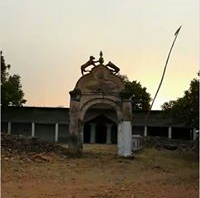 It has a Mandir or Gurudwara named 52 kothi 53 Dhwar It is built by Zamindar Munsi Ganga Prasad in year 1897. It is said that it has 52 no of Ashtadhatu statue on which some were stolen.
It has a Mandir or Gurudwara named 52 kothi 53 Dhwar It is built by Zamindar Munsi Ganga Prasad in year 1897. It is said that it has 52 no of Ashtadhatu statue on which some were stolen.
Panchu:-The KP Jayaswal Research Institute, during in the course of its Archaeological Explorations brought to light the site period Early medieval. Gonar Bigha:- The KP Jayaswal Research Institute, during in the course of its Archaeological Explorations brought to light the site period Late medieval. Dheuri:-The KP Jayaswal Research Institute, during in the course of its Archaeological Explorations brought to light the site period Early medieval. Sirampur:-The KP Jayaswal Research Institute, during in the course of its Archaeological Explorations brought to light the site period Early medieval. Chitarghatti:- The KP Jayaswal Research Institute, during in the course of its Archaeological Explorations brought to light the site period Early medieval. Barhauna:- The KP Jayaswal Research Institute, during in the course of its Archaeological Explorations brought to light the site period Early medieval. Hadsa:- The KP Jayaswal Research Institute, during in the course of its Archaeological Explorations brought to light the site period Early medieval. Bhadseni:- The KP Jayaswal Research Institute, during in the course of its Archaeological Explorations brought to light the site period Early medieval. Umrao Bigha;- The KP Jayaswal Research Institute, during in the course of its Archaeological Explorations brought to light the site period Early medieval. Nasratpur Phulwariya:- The KP Jayaswal Research Institute, during in the course of its Archaeological Explorations brought to light the site period Late medieval. Mahbatpur:- The KP Jayaswal Research Institute, during in the course of its Archaeological Explorations brought to light the site period Early medieval. Tungi:– The KP Jayaswal Research Institute, during in the course of its Archaeological Explorations brought to light the site period Early medieval. Latawar Faridpur:- The KP Jayaswal Research Institute, during in the course of its Archaeological Explorations brought to light the site period Early medieval. Budhaul:-The KP Jayaswal Research Institute, during in the course of its Archaeological Explorations brought to light the site period Early medieval. Ariyab:- The KP Jayaswal Research Institute, during in the course of its Archaeological Explorations brought to light the site period Kushan. Ranipur:- The KP Jayaswal Research Institute, during in the course of its Archaeological Explorations brought to light the site period Early medieval. Pachra:- The KP Jayaswal Research Institute, during in the course of its Archaeological Explorations brought to light the site period Early medieval. Lalgarh (Hisua):- The KP Jayaswal Research Institute, during in the course of its Archaeological Explorations brought to light the site period Early medieval. Bagodar:- The KP Jayaswal Research Institute, during in the course of its Archaeological Explorations brought to light the site period Early medieval.
KAWAKOL BLOCK
Had-Hadwa Waterfall :– It is about 6 kms from Kawakol in village Macehaudra. It is a seasonal (Rainy Season) water fall.
Sarvoday Asharam(Sekhodewra ):- It is situated one and half miles away from Kawakole Police station at Village Sekhodewra . This Ashram inaugurated by Desh Deshratna 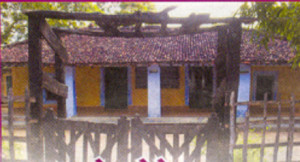 Dr. Rajendra Prasad and nourished by Shri Jai Prakash Narayan .The site of the ashram is beautiful with the background of hills. This hills are also echo hills. If one’s stand against the highest of the hillocks and shouts, the voice is echoed back in the same human like tone.
Dr. Rajendra Prasad and nourished by Shri Jai Prakash Narayan .The site of the ashram is beautiful with the background of hills. This hills are also echo hills. If one’s stand against the highest of the hillocks and shouts, the voice is echoed back in the same human like tone.
An ancient image of Ganesha was found here, which is well preserved in the Naradah Museum.
Rupo:- An ancient image of Ganesha was found here, which is well preserved in the Naradah Museum.
